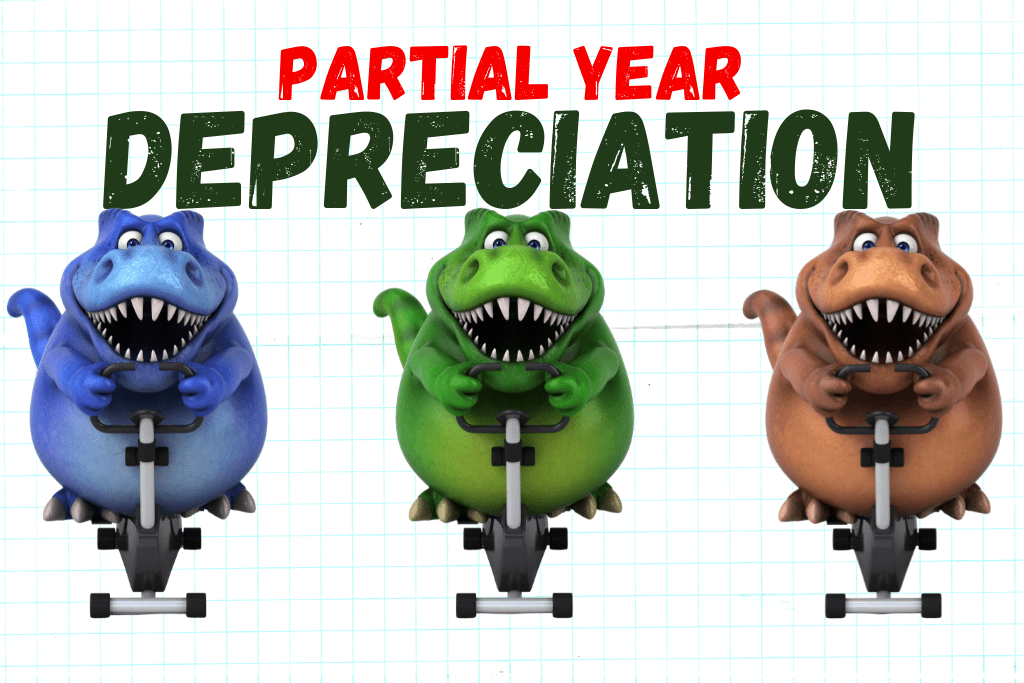When an asset is put in service in any month other than January (or first month of a fiscal year), a business generally takes depreciation only for the months the asset was owned. To calculate the amount of depreciation, take the calculated amount for the year, divide it by 12 to get the monthly expense, and multiply that number by the number of months the asset was owned.
For example, if a business purchases an Ford F350 truck on August 1, under Straight Line depreciation, we would take the depreciation expense for the first year $7,600, divide by 12 to get the monthly cost of $733. Then multiply that by the number of months the asset was owned–5. The first year’s depreciation would be $733 x 5 = $3665.
| Asset 1 | 20xx Ford F350 |
| Asset Name | Vehicles |
| Useful Life | 5 years |
| Cost (Basis) | $40,000 |
| Salvage Value | $2,000 |
| Units: Miles | 100,000 |
The depreciation expense to complete the five year period would be calculated as 7 months in the sixth year of the asset’s life. Five months in the first year, 12 months in years two through five, and seven months in year six.
| Depreciation Year 1 | 5 months |
| Depreciation Year 2 | 12 months |
| Depreciation Year 3 | 12 months |
| Depreciation Year 4 | 12 months |
| Depreciation Year 5 | 12 months |
| Depreciation Year 6 | 7 months |
What is the Journal Entry to Record Depreciation?
Whether a company records its depreciation monthly or yearly, an adjusting journal entry is made to adjust the balance of depreciation expense and to record the the loss of value of the asset in the accumulated depreciation account.
The journal entry is a debit to Depreciation Expense and a credit to the contra asset Accumulated Depreciation. In this case, we’ll assume the asset has $2,000 a year in depreciation (straight-line)
| Depreciation Expense | 2,000 | |
| Accumulated Depreciation | 2,000 |
When the entry is posted to the accounts, Depreciation Expense has increased and Accumulated Depreciation has increased. The new Accumulated Depreciation total then moves to the Balance Sheet where it shows the total reduction in the assets value from the time the asset was purchase. The Depreciation Expense is accumulating, adding up over time.
| Vehicles | $10,000 |
| Less Accumulated Depreciation | (2.000) |
| Net Book Value | $ 8,000 |
Assuming that the asset in question has a 5 year useful life and the company uses Straight Line Depreciation, the next year’s entry will be:
| Depreciation Expense | 2,000 | |
| Accumulated Depreciation | 2,000 |
The new Accumulated Depreciation amount will be $2,000 + $2,000 = $4,000. The Balance Sheet will now show this:
| Vehicles | $10,000 |
| Less Accumulated Depreciation | (4.000) |
| Net Book Value | $ 6,000 |
The Depreciation has Accumulated to $4,000. The Net Book Value of the asset is now $6,000. Notice we haven’t touched the original (historic) cost of the asset. We are tracking the loss in value using the Accumulated Depreciation contra asset account.
For more how-to tips about calculating depreciation, check out these articles:
-
Difference Between Depreciation, Depletion, Amortization
In this article we break down the differences between Depreciation, Amortization, and Depletion, discuss how each one is used, and what the journal entries are to record each. The main
-
Adjusting Journal Entries | Accounting Student Guide
When all the regular day-to-day transactions of an accounting period are completed, the next step is to check on the balances of certain accounts to see if those balances need
-
What is a Contra Account?
A contra account is an account used to offset the balance in a related account. When the main account is netted against the contra account, the contra account reduces the
-
How to Calculate Straight Line Depreciation
Straight-line Depreciation is used to depreciate Fixed Assets in equal amounts over the life of the asset. The basic formula to calculate Straight-line Depreciation is: (Cost – Salvage Value) /
-
How to Calculate Declining Balance Depreciation
Declining Balance Depreciation is an accelerated cost recovery (expensing) of an asset that expenses higher amounts at the start of an assets life and declining amounts as the class life
-
How to Calculate Units of Activity or Units of Production Depreciation
Units of Activity or Units of Production depreciation method is calculated using units of use for an asset. Those units may be based on mileage, hours, or output specific to

